Tokyo Tech's Summer Challenge, a unique opportunity for high school students to participate in university-level education while engaging with some of the world's top researchers, was held for the eighteenth straight year from August 3 to 5.
As was the case in 2020, Summer Challenge 2021 was held on Ookayama Campus rather than the off-campus overnight venue used in past years. Traditionally, participants go to Ranzan Town in Saitama Prefecture for a three-day-two-night camp, where they face a variety of scientific and technological challenges. Close contact in large numbers was again not an option this year due to COVID-19, so organizers created five engaging challenges that took place on Ookayama Campus over three days.
Outline of Summer Challenge 2021
Dates: August 3 to 5, 2021
Place: Tokyo Tech Front, Ookayama Campus
Number of participating students: 50
Tokyo Tech High School of Science and Technology: 35
Ochanomizu University Senior High School: 5
Tokyo Gakugei University Senior High School: 10
Tokyo Tech faculty: 24
High school teachers: 8 (from 3 schools)
Tokyo Tech administrative staff: 8
Total number of participants: 90
This year, participants included 50 third-year students from three high schools. After words of encouragement from Tokyo Tech Executive Vice President for Education Tetsuya Mizumoto, participants split into teams, rotating between groups throughout the day, and attacked the six challenges at Tokyo Tech Front while adhering to appropriate safety measures.
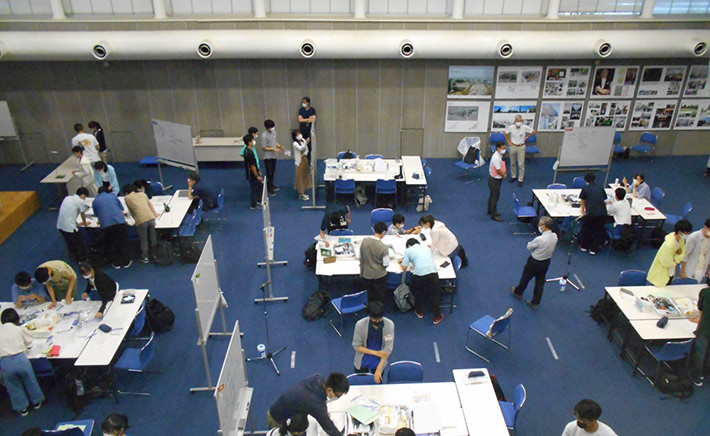
Summer Challenge 2021 participants at Tokyo Tech Front
Challenge #1: Column Land
Professor Kyoko Yamamuro
Department of Industrial Engineering and Economics, School of Engineering
Summer Challenge 2021 kicked off with Column Land, a popular Tokyo Tech class and effective icebreaker where students evaluate short anonymous pieces of writing prepared in advance by all participants. This year's topic, "cars," again revealed the diversity and creativity among the participants. Submissions included midnight discussions between toy cars, comparisons between infant and senior walkers, and other original texts sprinkled with puns, quizzes, and hidden messages. All texts were posted on walls around the venue so participants could examine them further during breaks between challenges.
High school teacher's comment:
- I believe this was one of the icebreakers used in previous years, and an excellent one at that! It allowed students to discuss how to evaluate items that have no evaluation criteria, and proved very effective despite not requiring any prior knowledge.
Challenge #2: Blueprint that forms the animal body
Professor Mikiko Tanaka
Department of Life Science and Technology, School of Life Science and Technology
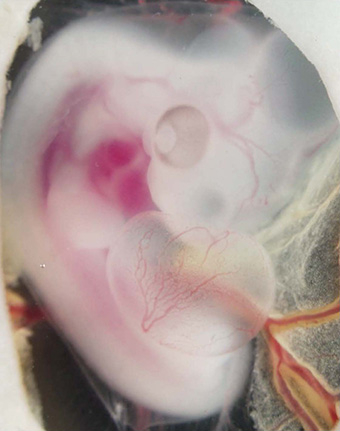 Chicken embryo after 5 days
Chicken embryo after 5 days
 Chicken embryo after 5 days
Chicken embryo after 5 days
This challenge introduced to students the research field that approaches the evolution of life from the perspective of "development." This involves inferring the evolutionary process by comparing how organs such as the face and limbs in different species are formed in the egg or in the mother's womb.
The students examined one case study that shows differences in development between sharks and humans. The openings that became gills in sharks, for example, evolved into ear holes and parathyroid glands in humans. After learning how certain animals evolved by altering the relative size and positioning of various body parts, participants were presented with a question: If you were free to conduct research using this developmental approach to evolution, what animal would you like to use as your subject?
Many seemed curious about the development of unique characteristics such as the flashy feathers of a peacock, the pouch of a kangaroo, or the luminescent organ of a butterfly fish. However, some students expressed interest in conducting comparative research solely on the tails of various animals. The participants learned that boldly predicting the process of body formation, testing the hypothesis, and planning the experiment are all part of a challenge that researchers undertake on a daily basis.
High school teacher's comment:
- It must have been refreshing for the students to be asked what kind of subject matter and methods they would use as a researcher.
Challenges #3 & #4: Elucidating mechanisms — Dissembling zippered plastic bags and pedometers
Associate Professor Mitsutoshi Ueda
Department of Materials Science and Engineering, School of Materials and Chemical Technology
The legendary disassembly challenge returned again this year. Throughout the years, Summer Challenge participants have dissembled and elucidated the mechanisms of various large items such as line-marking machines and coffee makers, as well as smaller ones such as miniature toy cars and ballpoint pens.
This year, the first target of analysis was the zippered plastic bag, a common and inexpensive item found in most kitchens. Students split into groups to observe and disassemble their bags to learn how they work. The more the groups examined their specimens, the more they were impressed by the precision with which the bags were designed for ease of use. In addition to cutting the bags into different sizes, the groups also used magnification loupes to get a closer look at different sections and springs to measure the force required to open the bags.
The focus during the disassembly of the second item, a pedometer, was measurement of error range. This range increased when users shuffled their feet or ran with the device. The big question was what kind of mechanism should be devised to eliminate this error range?
After sleeping on it, the groups presented their results on the following day. Each group was given 15 minutes to rehearse their presentations to ensure they stayed within the five-minute time limit and did not try to include too much content. As a result, most groups were able to improve their time management skills while sharing concise, accurate accounts of their observations.
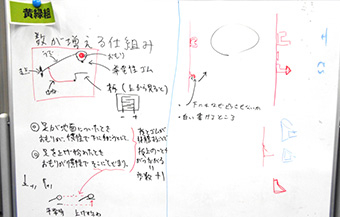
Understanding pedometer’s mechanism
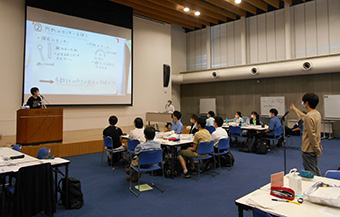
Active Q&A session
High school teachers' comments:
- The selected subject matter for this challenge always amazes me. The zippered bag is such a familiar yet profoundly thought out item.
- The preparation and execution of a presentation within a tight deadline was a good experience for students as they rarely experience this at school.
Challenge #5: How much do you really know about everyday plastics?
Professor Shinji Ando
Department of Chemical Science and Engineering, School of Materials and Chemical Technology
This challenge focused on the characteristics of the PET bottle, another commonplace item in Japan. To begin with, students were asked why some bottles are transparent, while others have a white mouth, and yet others have a pentagonal shape. Some students pointed out that different bottle types suited different contents. White mouths, for example, were more heat-resistant, while the five protrusions on other bottles were effective at dispersing pressure in soft drinks.
To test their predictions on whether different-colored bottle components were made of the same material, students then experimented by applying heat to bottles using a heat gun. The professor explained that, as the temperature rises, polymers that were not able to do so at lower temperatures become crystallite. This increase in crystallinity in the plastic increases its hardness and causes light scattering to occur, making transparent objects appear white. Seeing this phenomenon with their own eyes allowed students to understand that items which appear dissimilar may in fact be made of the same material.
Towards the latter part of this challenge, the discussion shifted from the wonders of the world of plastic and ever-changing polymers to environmental issues. What should we do when this amazing material is discarded, turning into minuscule microplastics that sink to the floors of our oceans? This shift in topics invited ideas from students for what we all can do immediately to help achieve the Sustainable Development Goals.
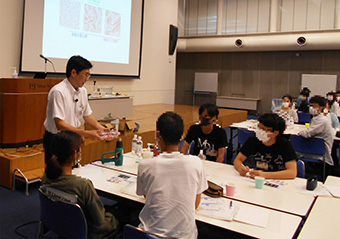
Prof. Ando (left) showing what happens when heat is applied to mouth of plastic bottle
High school teacher's comment:
- Learning about polymers through familiar products and environmental issues was both interesting and easy to understand. The results of the experiments were clear, even for those just watching from the sidelines.
Challenge #6: The essence of computer science through puzzles
Associate Professor Ryo Kashima
Department of Mathematical and Computing Science, School of Computing
The final challenge began with two sets of playing cards placed onto tables. Under the guidance of Associate Professor Ryo Kashima, students were asked to solve two puzzles which involved changing the starting card sequence to the final card sequence while following a set of rules. The aim was to focus on how things change depending on where the students split up the sequence.
"How many of you solved the first puzzle?" Approximately half of the students raised their hand. "Good," said the professor.
"How many of you solved the second one?" Nobody raised their hand. "Also good, because the second one has no solution," the professor grinned.
"There is in fact a strategy that allows us to get the correct solution without trial and error," the professor explained. "This strategy also gives us no solution to the second puzzle. Let's prove that this strategy will always give us the correct answer."
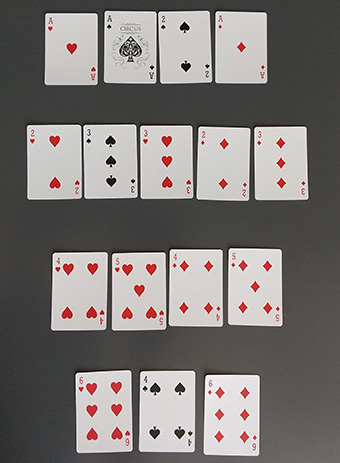
Exploring theorems with playing cards
While navigating advanced technical terms such as confluence and uniqueness, the students flexibly kept up with the pace of the professor’s explanations. They then dove into attempts to prove three theorems. At first, the students thought over the issues individually, and then proceeded to discuss the proofs in groups. Debates around the whiteboard were so heated that the time limit had to be extended. Afterwards, the professor offered his explanations, allowing all groups to supplement the understanding they had gained during the group discussions.
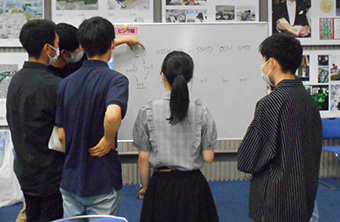
Proving strategy in teams
To conclude, the professor touched on how these puzzles relate to computer science, and mentioned puzzles for which no strategies exist. Overall, Challenge 6 provided students with a golden opportunity to touch on computer science from a mathematical perspective.
High school teachers' comments:
- Inquiry activities in mathematics are quite rare at the high school level, so I think even the teachers enjoyed this one! The content may have been tough for the students, but it offered them a great chance to experience university-level mathematics.
- This was a tough challenge, but I think it made everyone want to consult with those around them.
Tokyo Tech's high school-university collaboration in education — 18 successful years
Since 2004, Tokyo Tech has been offering opportunities for high school students to experience university-level education through various events including the Summer Challenge. Academic year 2021 marks the final year of this collaborative program, but Tokyo Tech remains dedicated to helping youngsters develop a vision of their future, advance to university with clear objectives, and make tertiary education a natural extension of their high school education.
. Any information published on this site will be valid in relation to Science Tokyo.









